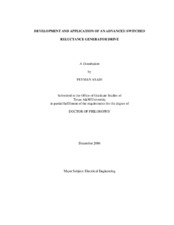| dc.description.abstract | This dissertation contains the results of research conducted on the design and
control characterization of a Switched Reluctance Generator (SRG) for maximum output
power. The SRG is an attractive solution to the increasing worldwide demand of
electrical energy. It is low cost with a rugged structure, operates with high efficiency over
a wide speed range, and is fault tolerant. In many applications, size and weight are the
main criteria in selecting the generator. Hence, in design and control of the generator,
system designers always strive for increasing power density, or in other words,
maximizing the output power for a given size. Despite the extensive research on the
motoring operation of the Switched Reluctance Machine, only a few publications have
investigated the generating mode of operation of this machine. Results and algorithms
from this research can be referenced for better utilizing the SRG in many applications.
As the first stage to output power maximization, design parameters and control
variables affecting the average output power of the SRG are identified through a
systematic approach. The optimal values for maximizing the output power are found
through an analytical approach and iterative simulations. The results are then verified
experimentally. After finding the optimal values for control variables, a controller is designed.
This controller is model dependent. If the model used for design is not accurate or the
machine parameters are deviated from the designed values, the machine will not generate
the maximum output power. Therefore, a self-tuning algorithm, based on a local search
method, is proposed and experimentally tested. It works effectively and does not need
extra hardware or rigorous calculations.
The attempts to benefit from the SRG may look tantalizing, but it poses a
challenge as well. Output power maximization can lead to an oversized SRG converter
and its output filter, which will reduce the overall power density of the motor drive. The
last piece of this dissertation analyzes the effect of a commutation algorithm on the
output filter, reducing its size with active control of phase currents, and proposing a novel
control algorithm that was investigated through experiments over all of the speed range. | en |


